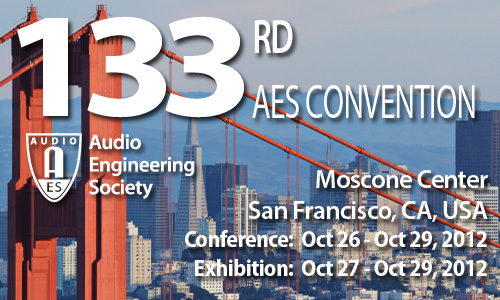
AES San Francisco 2012
Product Design Track Event EB3
Monday, October 29, 9:30 am — 11:00 am (Foyer)
Engineering Brief: EB3 - eBrief Presentations—Posters 2
EB3-1 Implementation of an Interactive 3-D Reverberator for Video Games Using Statistical Acoustics—Masataka Nakahara, ONFUTURE Ltd. - Tokyo, Japan; SONA Corp. - Tokyo, Japan; Tomoya Kishi, CAPCOM Co., Ltd. - Okaka-shi, Oasaka-fu, Japan; Kenji Kojima, CAPCOM Co. Ltd.; Toshiki Hanyu, Nihon University - Funabashi, Chiba, Japan; Kazuma Hoshi, Nihon University - Chiba-ken, Japan
An interactive reverberator, which applies realistic computed acoustic responses interactively to video game scenes, is a very important technology for the processing of in-game sounds. The mainframe of an interactive reverberator,
which the authors developed, is designed based on statistical acoustics theory, so that it is possible to compute fast enough to realize real-time processing in fast-changing game scenes. Though statistical reverbs generally do not provide a high level of reality, the authors have achieved a quantum leap of sound quality by applying Hanyu's algorithm to conventional theories. The reverberator features: (1) No pre-computing jobs including room modeling are required. (2) Three-dimensional responses are generated automatically. (3) Complex factor of a room's shape, open-air areas, and effects of neighboring reverberations are expressed. The authors implemented the reverberator into a Capcom’s middleware experimentally and have verified it can run effectively. In this paper the algorithm, background theories, and implementation techniques are introduced.
Engineering Brief 67 (Download now)
EB3-2 Printable Loudspeaker Arrays for Flexible Substrates and Interactive Surfaces—Jess Rowland, University of California, Berkeley - Berkeley, CA, USA; Adrian Freed, University of California, Berkeley - Berkeley, CA, USA
Although planar loudspeaker drivers have been well explored for many years, a flat speaker array system that may flex or fold freely remains a current challenge to engineer. We will demonstrate a viable technique for building large loudspeaker arrays that allow for diffused fields of sound transduction on flexible membranes. Planar voice coils are made from machine-cut copper sheets, or by inkjet printing and electroless copper plating, on paper, thin plastic, or similar lightweight material. We will present various ways of attaching thin magnets to these membranes, including a novel alternative strategy of mounting magnets in gloves worn by the listener. This creates an engaging experience for listeners in which gestures can control sounds from the speaker array interactively.
Engineering Brief 68 (Download now)
EB3-3 Nonlinear Distortion Measurement in Audio Amplifiers: The Perceptual Nonlinear Distortion Response—Phillip Minnick, University of Miami - Coral Gables, FL, USA
A new metric for measuring nonlinear distortion is introduced called the Perceptual Nonlinear Distortion Response (PNDR) to measure nonlinear distortion in audio amplifiers. This metric accounts for the auditory system's masking effects. Salient features of previously developed nonlinear distortion measurements are considered in the development of the PNDR. A small group of solid-state and valve audio amplifiers were subjected to various benchmark tests. A listening test was created to test perceptibility of nonlinear distortions generated in the amplifiers. These test results were analyzed and the Perceptual Nonlinear Distortion Response was more successful than traditionally used distortion metrics. This cognitive tool could provide the audio industry with more accurate test methods, facilitating product research and development.
Engineering Brief 69 (Download now)
EB3-4 EspGrid: A Protocol for Participatory Electronic Ensemble Performance—David Ogborn, McMaster University - Hamilton, ON, Canada
EspGrid is a protocol developed to streamline the sharing of timing, code, audio, and video in participatory electronic ensembles, such as laptop orchestras. An application implementing the protocol runs on every machine in the ensemble, and a series of “thin” helper objects connect the shared data to the diverse languages that live electronic musicians use during performance (Max, ChucK, SuperCollider, PD, etc.). The protocol/application has been developed and tested in the busy rehearsal and performance environment of McMaster University’s Cybernetic Orchestra, during the project “Scalable, Collective Traditions of Electronic Sound Performance” supported by Canada’s Social Sciences and Humanities Research Council (SSHRC), and the Arts Research Board of McMaster University.
Engineering Brief 70 (Download now)
EB3-5 A Microphone Technique for Improved Stereo Image, Spatial Realism, and Mixing Flexibility: STAGG (Stereo Technique for Augmented Ambience Gradient)—Jamie Tagg, McGill University - Montreal, Quebec, Canada
While working on location, recording engineers are often challenged by insufficient monitoring. Poor (temporary control room) acoustics or headphone monitoring can make judgments regarding microphone choice and placement difficult. These choices often lead to timbral, phase, and stereo image problems. We are often forced to choose between the improved spatial imaging of near-coincident techniques and the acoustic envelopment from spaced omni-directional mics. This poster proposes a new technique: STAAG (Stereo Technique for Augmented Ambience Gradient), which aims to improve stereo image, acoustic realism, and flexibility in the mix. The STAAG technique allows for adjustment of the acoustic envelopment once in a proper monitoring environment.
Engineering Brief 71 (Download now)
